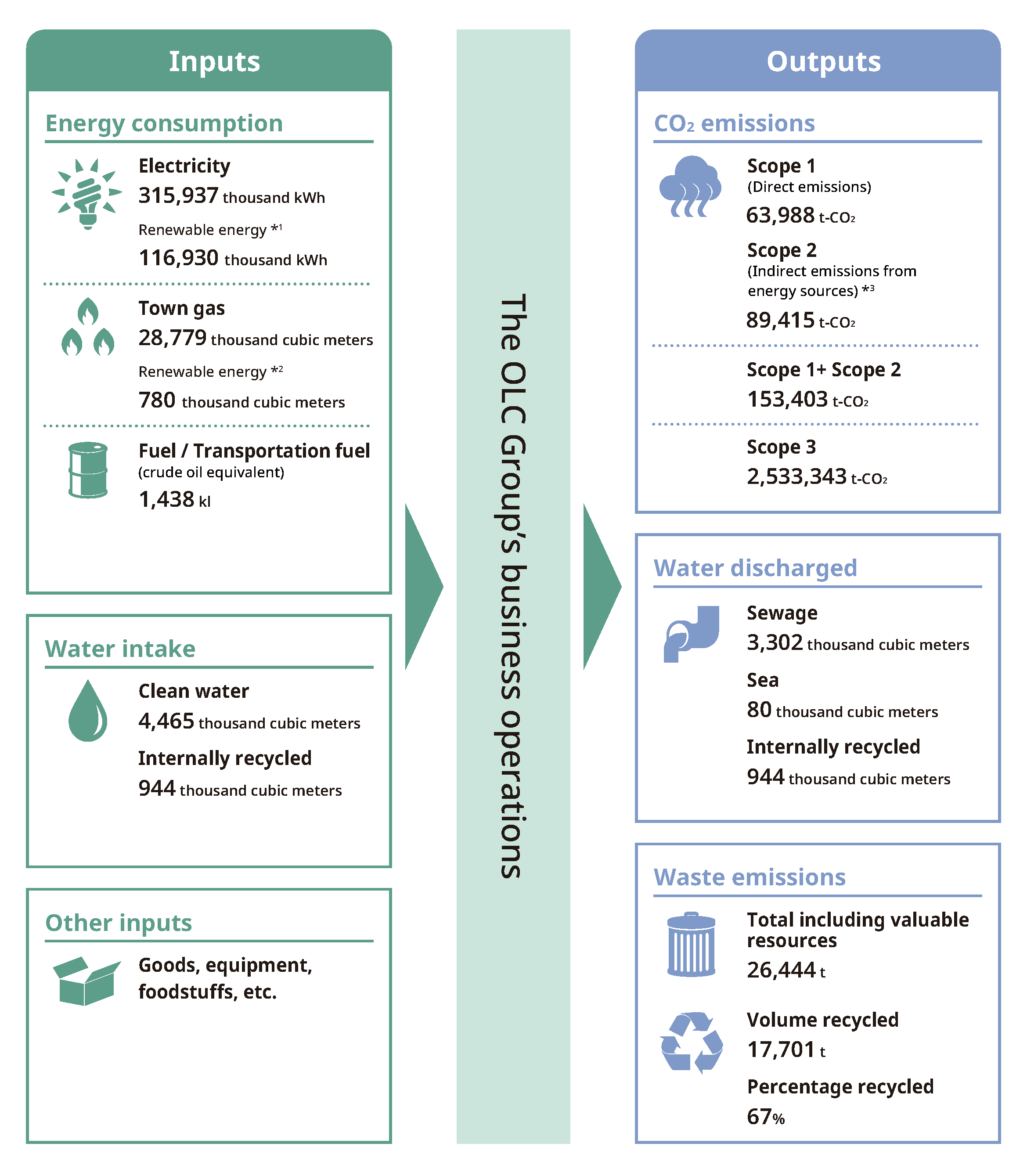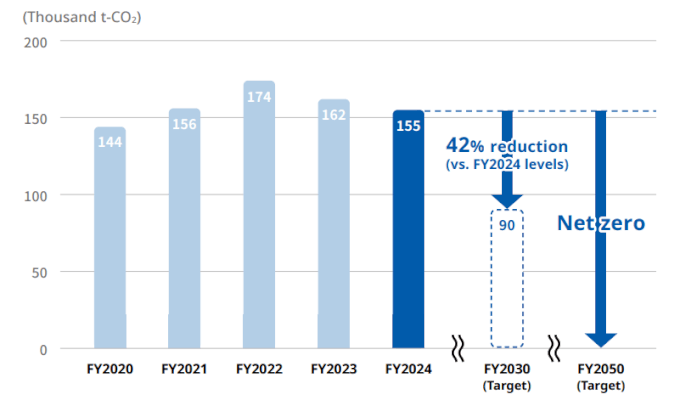The chart below indicates the environmental impact of the business operations of the OLC Group in FY2024. For example, Tokyo Disney Resort’s environmental efforts touch on a variety of areas including energy management, water processing, waste management, and recycling activities. We give due consideration to a range of environmental factors to reduce the burden on the global environment produced by our business activities.
Inputs (i.e., external factors that contribute to the environmental impact of our operations) include energy (electricity, city gas, fuel, etc.), water (clean water), various goods, equipment and food. Outputs (i.e., emissions resulting from our business activities) include carbon dioxide, wastewater released into the sewage system, and waste (including valuable resources).
The environmental impact mass balance, changes in CO₂ emissions, and yearly data cover approximately 98% of the OLC Group’s direct business areas (Theme Park Segment, Hotel Business Segment, and Other Business Segment) in terms of FY2024 net sales composition.

*1 In-house power generation by solar panels (all consumed by in-house operations), procurement of electricity with non-FIT non-fossil certificate
*2 Procurement of carbon-neutral town gas
*3 Scope 2 emissions are calculated based on the market-based method.
|
||||||||||||||||||||||||||||||||||||||||||||||||||||||||||||||||||||||||||||||||
|
||||||||||||||||||||||||||||||||||||||||||||||||||||||||||||||||||||||||||||||||||||||||||
*1 The data up to FY2021 pertain to Tokyo Disney Resort
*2 Tokyo Electric Power Company’s adjusted emissions factor is used to calculate CO₂ emissions from electricity consumption.
Includes CO₂ emissions from transportation.
CO₂ emissions include emissions of hydrofluorocarbons (HFCs) from FY2022.
Scope 2 emissions are calculated based on the market-based method.
*3 Added the FY2023 actual results for Theme Parks, hotels, and Ikspiari to the amount of water recycled at owned facilities

*Scope 2 emissions are calculated based on the market-based method.
| (t-CO₂) | ||||||||||||||||||||||||||||||||||||||||||||||||||||||||||||||||||||||||||||||||||||||||
|
||||||||||||||||||||||||||||||||||||||||||||||||||||||||||||||||||||||||||||||||||||||||
*1 Database of emissions unit values for calculating the emissions of greenhouse gases, etc. of an organization through its supply chain (Ver. 3.5), Ministry of the Environment
*2 Environmental measure B303, FY2020 Water Supply Business Guidelines performance indicators, Public Enterprises Bureau, Chiba Prefectural Government
*3 Inventory Database for Environmental Analysis (IDEA) Ver.3.5
*4 Category 2 rose in FY2024 due to an increase in fixed assets associated with the development of Fantasy Springs.
(Emissions from Group companies were calculated by multiplying the OLC Group’s emissions by the composition of consolidated net sales.)
| (thousand cubic meters) | |||||||||||||||||||||||||||||||||||||||||||||||||||||||||||||||||
|
|||||||||||||||||||||||||||||||||||||||||||||||||||||||||||||||||
| (t) | ||||||||||
|
*Chemical Oxygen Demand
|
Waste generated on this chart is that entrusted to recycling for The Japan Container and Packaging Recycling Association based on The Containers and Packaging Recycling Law.
| (t) | ||||||||||||||||||||||||||||||||||||||||||||||||||||||||||||||||||||||||||||||||||||||||||||
|
||||||||||||||||||||||||||||||||||||||||||||||||||||||||||||||||||||||||||||||||||||||||||||
Tokyo Disney Resort
|
||||||||||||||||||||||||||||||||||||||
*1 Output: Discharge of resources
*2 Input: Inflow of resources
*3 Recycling: Recycling of resource
*The FY2023 result increased significantly due to a legal revision, which resulted in the inclusion of chemical substances primarily contained in cleaning agents in the PRTR list.
|
| (t) | ||||||||||
|
* Conducted a voluntary survey of 100 main VOCs listed by the Ministry of the Environment.
* VOC volume of FY2021 has been revised due to review of past data.
|
We have specified "Measures to address climate change and natural disasters" and “Recycling-oriented society” as areas of our ESG Materiality to achieve our vision for the period leading up to 2035, and have set specific targets.